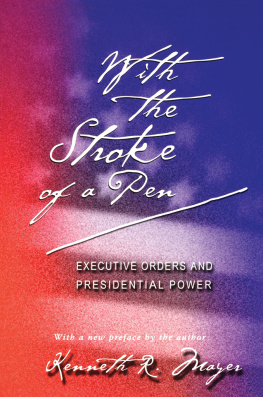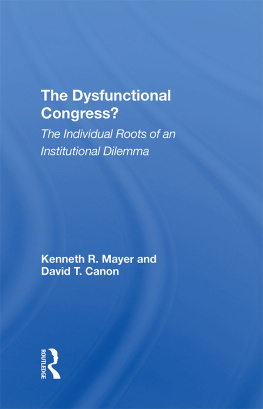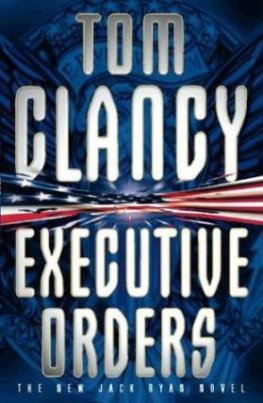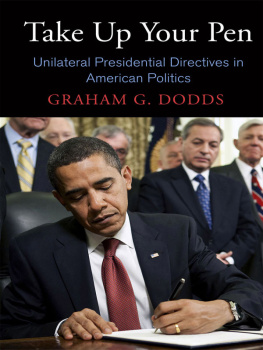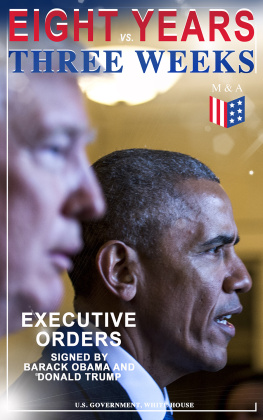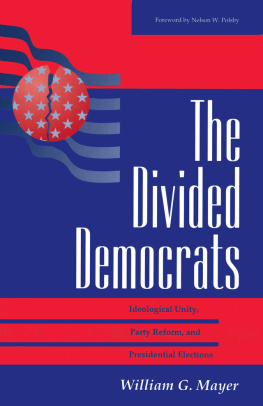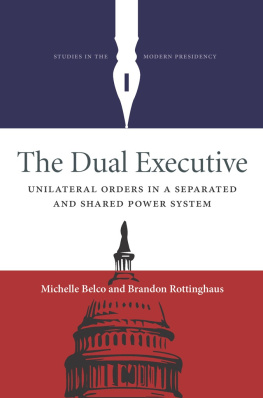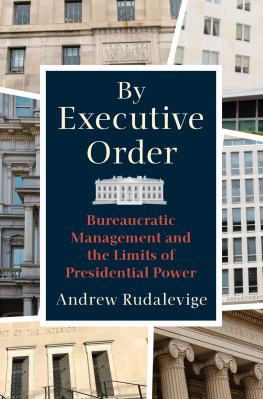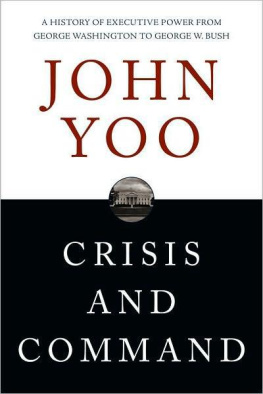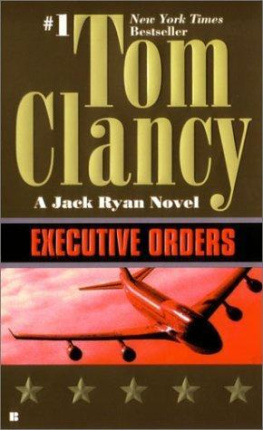Copyright 2001 by Princeton University Press
Published by Princeton University Press, 41 William Street, Princeton, New Jersey 08540
In the United Kingdom: Princeton University Press,
3 Market Place, Woodstock, Oxfordshire 0X20 1SY
All Rights Reserved
Second printing, and first paperback printing, with a new preface, 2002
Paperback ISBN 0-691-09499-3
The Library of Congress has cataloged the cloth edition of this book as follows
Mayer, Kenneth R.
With the stroke of a pen: executive orders and presidential power / Kenneth R. Mayer.
p. cm.
Includes bibliographical references and index.
ISBN 0-691-01204-0 (CL: alk. paper)
1. Executive ordersUnited States. 2. PresidentsUnited States.
I. Title.
KF5053 .M39 2001
342.73'062dc21 00-064264
https://press.princeton.edu
eISBN: 978-1-400-82424-3
R0
Preface to the Paperback Edition_______________
I COMPLETED THE manuscript for the hardcover edition of this book during the summer of 2000. The next fifteen months confirmed, in events ranging from the petty to the catastrophic, my central thesisthat presidents retain substantial unilateral powers. Two periods of events in particular provided the best evidence.
As President Clintons term wound down, his behavior reaffirmed the belief that presidents who are about to leave the White House to the opposition party are prone to do whatever they can to put a last-minute stamp on national policy. In his last month and a half in office, Clinton issued twenty-one executive orders, a figure over four times the average during his term. While some were routine, others made substantive policy: Clinton revoked an executive order imposing ethics requirements on administration officials (Executive Order 13184, December 28, 2000); prohibited the importation of rough diamonds from Sierra Leone (Executive Order 13194, January 18, 2001); implemented a program to provide compensation for workers injured during the manufacture of nuclear weapons (Executive Order 13179, December 7, 2000); created a 120,000 square-mile ecosystem preserve off of Hawaii (Executive Order 13178, December 4, 2000); and initiated numerous presidential advisory commissions and task forces. On one of the last days of his term, Clinton created seven new national monuments (Proclamations 7933-7999, all issued on January 17, 2001).
Administration officials also hustled through a number of major regulationsthe most public being lower limits on permissible arsenic levels in drinking water and controversial ergonomics rules for the officethat had been in the works for years. And Clintons last-minute pardons proved extremely controversial (although it turned out that many presidents had also issued an unusually large number of presidential pardons and clemency orders at term-end). As the National Journal's Carl Cannon put it,
[I]n the last weeks, this was not just an active President. This was a whirling dervish of a President who appointed judges, signed treaties, gave campaign-style speeches, issued scads of executive orders, rescinded ethics regulations he had penned in his first term, raised political money, gave dozens of interviews, granted 235 pardons and clemencies, fired an enemy from her government job, negotiated his own plea-bargain agreement, cast aspersions on his successor, installed a crony as head of the Democratic Party, and gave an entire series of farewell addresses in which he essentially said he wasnt really leaving at all.
The first seven months of the Bush administration were relatively quiet, although the new president continued the practice of using executive orders to put new policies into place. President Bush established, via executive order, the White House Office of Faith-Based Initiatives (Executive Orders 13198 and 13199, January 29, 2001). Bush also reversed a Clinton-era order on union dues. Under Clintons executive order, unions no longer had to post a notice informing union members that they could request a refund of union dues collected for political activity. Executive Order 13201, which Bush signed in February 2001, reinstated the policy of requiring unions to post the notice. Although seemingly inconsequential, many unions saw the Bush order as a direct challenge to the gains they had made during the Clinton years.
The September 11 attacks brought presidential power into unusually sharp relief, however, as wars and national crises often do. In the wake of the attacks, Bush created the Office of Homeland Security in the Executive Office of the President (Executive Order 13228, October 8, 2001); established the policy of trying suspected terrorists before military tribunals rather than civilian courts; was authorized by Congress to spend up to $20 billion in response to the attacks with only minimal oversight; and delegated some powers that most people did not even realize that he had, such as the authority to order the military to shoot down civilian airliners that had been hijacked. As part of an ongoing policy of insuring continuity of government leadership in the event of a catastrophic attack, Bush clarified the succession process in nine cabinet agencies (Executive Orders 13241-13247, December 18, 2001; Executive Orders 13250-13251, December 28, 2001). The Justice Department, with clear presidential approval, also issued a series of controversial regulations, including a policy of listening in on certain attorney-client conversations of detained individuals suspected of terrorist connections. Supporters hailed Bushs initiative and forcefulness as necessary leadership; critics raised concerns about the legal authority behind many of his actions.
It is far too early to know how all of this will play out. What is clear, however, is that the past year and a half has demonstrated in dramatic fashion that executive power does indeed matter.
Notes
Carl Cannon, The Long Goodbye, National Journal (January 27, 2001): 33.
Joshua Micah Marshall, Payback Time, The American Prospect (April 9, 2001): 12-13.
Edward Walsh, Arsenic Drinking Water Standard Issued; After Seven-Month Scientific Review, EPA Backs Clinton-Established Levels, Washington Post, November 1, 2001, A31.
For discussions of President Bushs use of unilateral powers during his first year, see Alexis Simendinger, Power of One, National Journal (January 26, 2002): 230-235.
Acknowledgments
IN THE COURSE of writing this book I have incurred so many debts that I hardly know how to begin to acknowledge them. I will exhaust the adjectives that I must use to describe this helpcrucial, lucid, helpful, critical, generous, professional, invaluablelong before I can properly express my enduring gratitude. The best place to start is to acknowledge the generous financial support I received from the Graduate School Research Committee at the University of Wisconsin, the National Science Foundation (SBR-9511444), the Harry S Truman Library Foundation, the Gerald R. Ford Library Foundation, and the Eisenhower World Affairs Institute. Just as important are the lucid and helpful comments many colleagues and friends have provided. Larry Berman, David Canon, Steven DiTullio, Charles Franklin, Chuck Jones, John Kessel, Martha Joynt Kumar, Ken Meier, Richard Neustadt, Lyn Ragsdale, Bert Rockman, Robert Shapiro, Mary Stuckey, Stephen Wayne, Graham Wilson, and Tom Weko all gave generously of their time and knowledge, as did my fellow participants in the Presidency in the 21st Century Conference (held at Columbia University in 1996 to honor Neustadts contribution to presidential studies). The archivists and staff at the presidential libraries were a treasure, and endlessly patient with me. A number of current and former government officials graciously consented to detailed interviews; most requested anonymity, but some (particularly former White House counsel Lloyd Cuter) agreed to go on the record. Patrick Murphy, Lisa Nelson, Kevin Price, and Matt Beck provided invaluable research assistance. Malcolm Litchfield at Princeton University Press signed on to this project early, taking a significant risk in the process, and his successor, Chuck Myers, guided the manuscript to completion with a steady and enthusiastic hand. Elizabeth Gilbert was an extraordinary copyeditor, gently correcting my bad writing habits as she went over the manuscript with great care. Louis Fisher and David Gray Adler read the entire manuscript, and provided crucial advice and support; I owe a special intellectual debt to Fisher, whose work spurred my original interest in the legal basis of presidential power.

